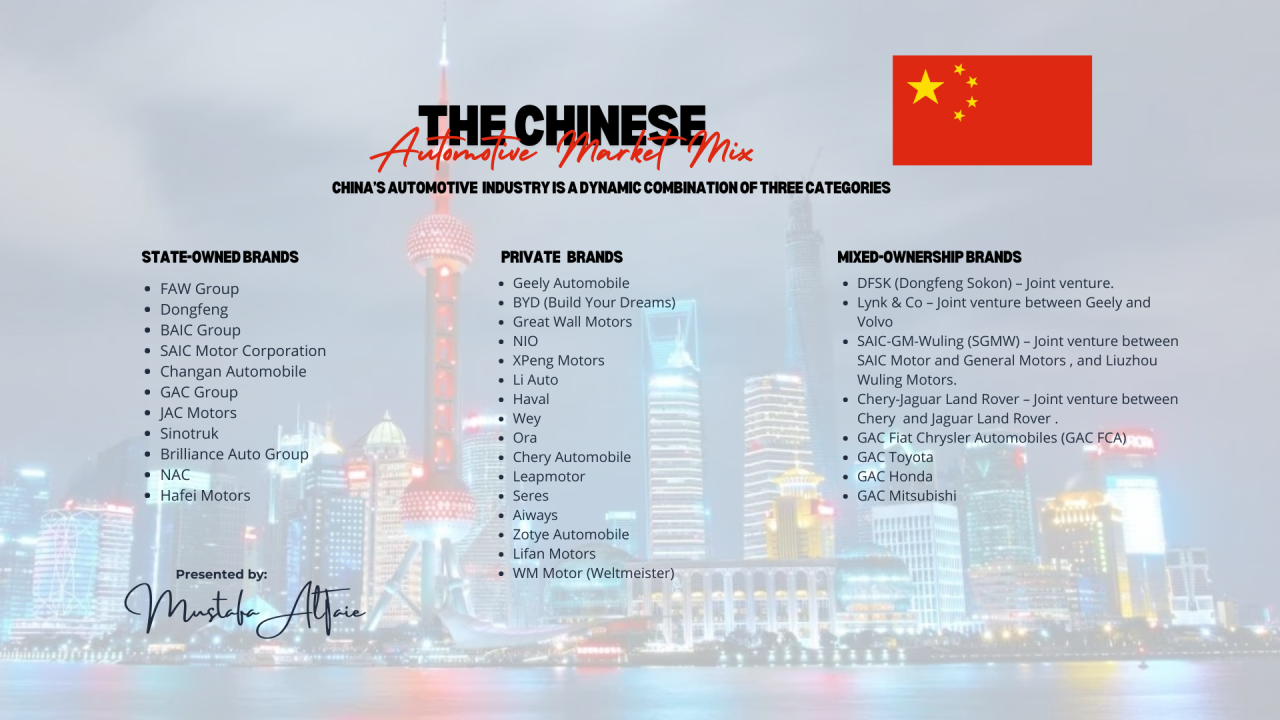The Chinese Automotive Market: A Case Study Of BMW And Porsche's Difficulties

Table of Contents
Intense Competition in the Chinese Automotive Market
The Chinese automotive market is no longer dominated solely by international players. The rise of domestic brands and shifting consumer preferences create a complex and highly competitive environment.
The Rise of Domestic Brands
Chinese car brands are rapidly gaining market share, posing a significant threat to established international players like BMW and Porsche. This success is driven by several key factors:
- Technological advancements: Domestic automakers like BYD, Nio, and Xpeng are investing heavily in electric vehicle (EV) technology, autonomous driving features, and advanced connectivity solutions, often exceeding the offerings of some international competitors in certain areas.
- Government support: The Chinese government actively promotes the growth of its domestic automotive industry through subsidies, tax breaks, and infrastructure development, giving local brands a considerable advantage.
- Appealing pricing strategies: Chinese car brands frequently offer competitive pricing, making their vehicles more accessible to a broader range of consumers than many international luxury brands. This price competitiveness is a major factor impacting market share.
These factors have created intense competition in China's automotive market, forcing international brands to reassess their strategies.
Shifting Consumer Preferences
Chinese consumer preferences are rapidly evolving, demanding vehicles that are not only luxurious but also technologically advanced and environmentally conscious.
- Growing preference for EVs and hybrids: The Chinese market shows a strong preference for electric vehicles and hybrid models, driven by government incentives and growing environmental awareness. This shift necessitates significant investment in EV technology for international brands.
- Importance of digital connectivity: Chinese consumers value vehicles with advanced infotainment systems, seamless smartphone integration, and robust digital connectivity features. This demand for technology is a critical factor in purchase decisions.
- Focus on luxury and status symbols: While price is a factor, luxury and brand image remain important considerations for many Chinese consumers, especially in the luxury car market in China.
Understanding and adapting to these evolving preferences is vital for success in the Chinese automotive market.
Supply Chain Disruptions and Economic Fluctuations
External factors also significantly impact the Chinese automotive market's stability.
- Impact of chip shortages: Global supply chain disruptions, particularly the semiconductor chip shortage, have impacted production and sales across the entire industry, including BMW and Porsche.
- Fluctuations in the Chinese economy: Economic uncertainties within China can directly affect consumer spending and investment in the automotive sector. Economic downturns can significantly impact car sales.
- Geopolitical Factors: International tensions and trade policies can also disrupt supply chains and impact market stability.
These external factors contribute to the overall volatility and uncertainty of the Chinese automotive market, requiring robust risk management strategies from international players.
Specific Challenges Faced by BMW and Porsche
BMW and Porsche, despite their global brand recognition, face unique challenges in the Chinese automotive market.
Pricing Strategies and Market Positioning
Balancing competitive pricing with brand prestige is a significant challenge.
- Pressure to offer competitive pricing: The intense competition from both domestic and other international brands necessitates offering competitive pricing, especially in the luxury car pricing segment.
- Maintaining brand image and profitability: Lowering prices too much can negatively impact brand image and profitability, a crucial balancing act for luxury brands.
- Adjusting to local market demands: Luxury brands must adapt their pricing and product offerings to meet the specific demands and preferences of the Chinese market.
Adapting to Local Regulations and Consumer Needs
Navigating China's complex regulatory environment and tailoring products to local consumer needs is crucial.
- Meeting emission standards: China has stringent emission standards that require significant investment in cleaner technologies.
- Complying with safety regulations: Adherence to Chinese safety regulations is mandatory and requires thorough understanding and adaptation.
- Localizing marketing campaigns: Effective marketing campaigns require a deep understanding of local culture and consumer preferences. Generic campaigns rarely succeed in the Chinese market.
Building Brand Loyalty and Trust
Establishing strong relationships with Chinese consumers and fostering brand trust is paramount.
- Importance of effective marketing and communication strategies: Building brand loyalty requires tailored marketing strategies that resonate with the Chinese consumer.
- Building strong dealer networks: A robust and reliable dealer network is essential for providing excellent after-sales service and building customer trust.
- Addressing concerns regarding quality and after-sales service: Addressing any concerns about quality and after-sales service promptly and transparently is critical for maintaining a positive brand image.
Conclusion
The Chinese automotive market presents unparalleled opportunities, but success requires navigating a complex interplay of competition, shifting consumer preferences, and economic factors. BMW and Porsche, despite their global success, face significant hurdles in this rapidly evolving landscape. To thrive, international brands must prioritize adapting to local regulations, understanding the evolving needs of Chinese consumers, and building strong, localized strategies. Mastering these challenges is key to success in the dynamic and lucrative Chinese automotive market. Further research into specific marketing campaigns and technological adaptations will reveal even more crucial insights into effective strategies within this competitive market. Successfully navigating the complexities of the Chinese automotive market requires a deep understanding of local dynamics and a commitment to long-term investment and adaptation.

Featured Posts
-
 Former Ukrainian Official Shot Dead Outside Madrid School
May 22, 2025
Former Ukrainian Official Shot Dead Outside Madrid School
May 22, 2025 -
 Mission Patrimoine 2025 Deux Sites Bretons A Plouzane Et Clisson Selectionnes Pour Restauration
May 22, 2025
Mission Patrimoine 2025 Deux Sites Bretons A Plouzane Et Clisson Selectionnes Pour Restauration
May 22, 2025 -
 Loire Atlantique Un Quiz Pour Evaluer Vos Connaissances Histoire Gastronomie Culture
May 22, 2025
Loire Atlantique Un Quiz Pour Evaluer Vos Connaissances Histoire Gastronomie Culture
May 22, 2025 -
 Frimpong Agrees To Transfer Awaits Club Contact Liverpool News
May 22, 2025
Frimpong Agrees To Transfer Awaits Club Contact Liverpool News
May 22, 2025 -
 Updated The Trans Australia Run World Record Race
May 22, 2025
Updated The Trans Australia Run World Record Race
May 22, 2025
